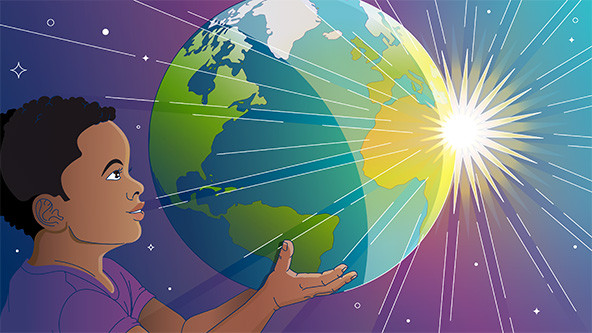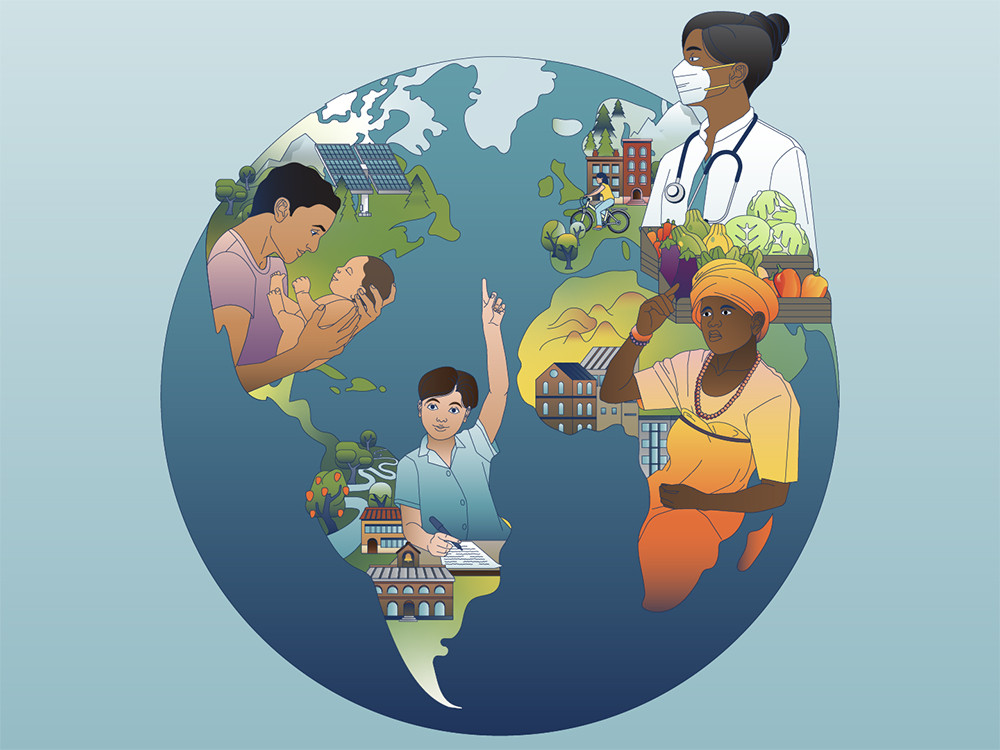 (Illustration courtesy of the Robert Wood Johnson Foundation)
(Illustration courtesy of the Robert Wood Johnson Foundation)
Having recently returned to the United States from the Health Equity of the Americas conference in Costa Rica, where I literally crossed borders to participate in cross-border learning, this feels like a good time to reflect on what’s been shared and learned throughout this essay series. The trip also got me thinking more about the learning journey I’ve been on with colleagues at the Robert Wood Johnson Foundation (RWJF) exploring the role of well-being in advancing health equity (more on that later).
In Costa Rica, much of our conversation focused on the nexus of health equity and decolonization of knowledge, which has been a central theme for this series.

As I read these essays, I was struck by how much we stand to learn from each other when we open ourselves to ideas and experiences from other places with humility, respect, and genuine enthusiasm for how they might help us solve our own challenges wherever we are. When we all share knowledge—break it out of traditional silos and invite in new or different perspectives—we increase its value. It becomes a common good that we can all tap into.
That doesn’t always mean replicating good ideas when we find them but assessing them with an eye to how they may be adapted to the unique social, political, economic, and geographic conditions in our respective communities
In her essay on health and climate solutions from cities around the world, Mehrnaz Ghojeh of C40 Cities points to the example of superblocks in Barcelona where local officials have turned car-centric streets into public spaces. Ghojeh says that more than 2,500 cities—including Berlin, Bogota, and even Los Angeles—are exploring this idea. It’s possible that superblocks in these places will look very different; in fact, we may wind up with 2,500 versions. “Good ideas can’t always be replicated exactly,” Ghojeh points out, “but they can be adapted and inspire others.”
The ability to draw inspiration from the success of others is critical to fueling progress at home. In the United States, we can take important lessons on how to make amends for historical racial injustice from the New Zealand government’s reparations to the Māori people. Following decades of activism by Māori leaders, the government by mid-2018 had signed 72 reparations settlements valued at $2.24 billion into law.
New Zealand, writes Vox race and policy reporter Fabiola Cineas in her essay, is an example of “what happens when a colonizer admits wrongdoing to the ancestors of those it colonized.” Cineas challenges the United States to do the same for Black people and Native Americans whose ancestors were enslaved or displaced. “If Māori could fight for reparations and win, surely more US leaders could at least begin to take the conversation about compensation for historic abuses seriously as a strategy to rectify disparities in health, education, housing, wealth, and more.”
That, Donald Warne would say, requires acknowledging the truth about our country’s history and its current reality. “To achieve equity, we must walk through truth,” Warne, a doctor and a member of the Oglala Lakota tribe from Pine Ridge, South Dakota, writes in his piece on Indigenous wisdom and community health equity. Solutions to our most intractable challenges, he says, require “bi-directional engagement and opportunities to learn from each other.” For example, the culture of Indigenous Peoples is rooted in the community, where everyone has a voice and everyone matters. American culture prioritizes the individual. Each may have something to learn from the other.
Inclusion has been an important theme throughout this series as well. We must not only enlist the voices of those who historically have not been included; power must also be shared. Mar Márquez, a gender equity activist and political scientist, is concerned with activating and empowering the voices of young people, especially those from LGBTQ+ communities. In her essay on advancing equity by centering young voices, she explores lessons learned from Colombia, which, following five decades of armed conflict, established youth councils at all levels of government. Today, people ages 14 to 28 vote for youth representatives to serve on councils throughout the country.
It is difficult to imagine something like this ever happening in the United States where so many young people feel disenfranchised and ignored, but is it impossible? Márquez writes that young people “must be partners, not mere spectators” in policymaking processes and decision-making.
Embracing inclusive and participatory approaches to solving society’s ills can produce real, tangible results, as Rwanda has shown. In their essay, Agnes Binagwaho, cofounder of the University of Global Health Equity in Rwanda, and her colleague Kevin Kubwimana recount lessons from Rwanda’s remarkable achievements in reducing maternal and child mortality rates.
In 2007, the Rwandan government reformed its national community health system using a highly participatory approach that centered the voices of woman and local communities and put trust in local providers. Since launching this system, maternal mortality rates have fallen by 42 percent and under-5 mortality rates have declined by 50 percent.
Meanwhile, in the United States, maternity mortality rates are on the rise, especially for Black women, whose rates are three times higher than rates for white women. Binagwaho and Kubwimana urge US leaders to “prioritize community engagement, invest in primary health care, strengthen the role of community health care, and ensure equitable access to quality health care services.”
These are just a handful of the significant learnings I’ve picked up from this series; plenty more abound. I am struck by how—when you open yourself up to global learning—you also open yourself up to more creative and wholistic thinking, which in turn often leads to more creative and wholistic solutions that can benefit everyone.
At RWJF, we have been engaged for several years on a global learning journey into the meaning of well-being and how it might help us achieve health equity. As the nation’s largest philanthropic organization dedicated solely to advancing health and health equity in the United States, we recognized promoting well-being as part of our mission, but we hadn’t deeply explored its meaning.
In September 2018, the foundation convened a diverse group of global thinkers in Bellagio, Italy, to explore how countries around the world conceptualize and integrate well-being into government policy, resource allocation, and measures of social progress. The idea was to learn about approaches in other countries that could inform policy and practice in the United States.
We heard examples from countries on nearly every continent that were already taking a well-being approach.
For example, drawing on Buddhist principals, the tiny country of Bhutan in the 1970s launched a Gross National Happiness (GNH) program that conducts a national assessment of well-being, as defined by nine “domains.” The data from the survey guide government policy, planning, and resource allocation. Results include innovative natural resources and tourism policies and Bhutan’s status as the world’s first carbon-negative country—within a framework of achieving sustainable and equitable development while preserving cultural traditions.
In Wales, the government passed the 2015 Wellbeing of Future Generations Act, which requires agencies to consider the long-term impact of policy decisions on future generations. How does this play out? So, for example, when developing a national plan for reducing traffic congestion in a sustainable way, government officials drew on evidence-based recommendations for building more railway stations, establishing more bus routes, and creating more bicycle lanes—instead of just paving new roads.
New Zealand introduced a well-being budget in 2019 to focus on the long-term impact of policies on quality of life. Its first well-being budget directed all new spending to achieving five well-being goals: improving mental health, reducing child poverty, supporting Indigenous Peoples, transitioning to a low-carbon-emission economy, and thriving in a digital age. The 2023 budget added a gender well-being component aimed at securing the well-being of diverse groups of women.
What I found most striking was how it defined well-being:
“Wellbeing is when people are able to lead fulfilling lives with purpose, balance, and meaning to them. Giving more New Zealanders capabilities to enjoy good wellbeing requires tackling the long-term challenges we face as a country, like the mental health crisis, child poverty, and domestic violence. It means improving the state of our environment, the strength of our communities, and the performance of our economy.”
Now, with a new administration running the country, the test may be maintaining the commitment to this approach, which illustrates a larger lesson for all efforts to advance progress on equity and well-being.
Historically, we in the United States tend to think of health and well-being in two ways: One has to do with the absence of disease and the other has to do with financial success, which, in Western societies like the United States, is often measured by Gross Domestic Product (GDP).
But neither of these models accounts for factors like satisfaction with life, social connectedness, financial security, and so on. As Bobby Kennedy famously said of GDP: “[I]t measures everything, in short, except that which makes life worthwhile.”
In addition, these two paradigms exclude many voices from important societal conversations. They don’t listen to communities, they don’t engage new or different voices, and they don’t try to learn from outside their own boundaries. They become self-reinforcing. As a result, they help perpetuate a system in which some people start behind and stay behind—or fall even further behind.
It’s time for change. We need to create a new standard that accounts for what it means to be human, what it means to live in a community together, and what it means to be part of a thriving society. It should advance community well-being—the combination of social economic, environmental, cultural, and political conditions that are essential for individuals and their communities to flourish and fulfill their potential. It also needs to flexible, recognizing that social well-being may look different in different communities, depending on the values and preferences of each community.
Ultimately, we at RWJF want to get to health equity, where everyone has a fair and just opportunity to live the healthiest life possible. A commitment to advancing our collective well-being can help us get there.
Think about it. What if, instead of focusing primarily on how many dollars’ worth of stuff we as a society produce and consume every year, we paid more attention to how much we strengthen communities, improve children’s happiness, make life easier for working families, and safeguard our planet?
For RWJF, this has been an illuminating journey on well-being—with our focus now on translating what we’ve learned and adapting it for our own context and conditions in the United States. It’s also a journey that has been inspired, informed, driven, and enriched by global learning.
As we conclude this essay series, I encourage you to join us or embark on your own global learning journey. There is so much we can learn from each other, regardless of where we live on this planet. Our world needs global thinkers—people who are willing to reach beyond borders (physical or otherwise) to exchange new ideas so that we can all have better futures, not just for ourselves but for generations to come.
Support SSIR’s coverage of cross-sector solutions to global challenges.
Help us further the reach of innovative ideas. Donate today.
Read more stories by Alonzo Plough.

